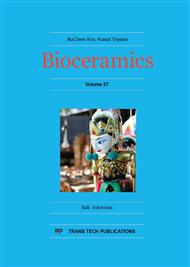[1]
B. Cales, Colored zirconia ceramics for dental application, Bioceramics. 11 (1998) 591-594.
Google Scholar
[2]
M. Bagby, S.J. Marshall, and G.W. Marshall, Metal ceramic compatibility: a review of the literature, J Prosthet Dent. 63 (1990), 21-25.
Google Scholar
[3]
J. Jitcharoen, N.P. Padture, A.E. Giannakopoulos and S. Suresh, Hertzian-Crack Suppression in Ceramics with Elastic-Modulus-Graded Surfaces, J Am Ceram Soc. 81 (1998) 2301- 2308.
DOI: 10.1111/j.1151-2916.1998.tb02625.x
Google Scholar
[4]
D.C. Pender, N.P. Padture, A.E. Giannakopoulos, and S. Suresh, Gradients in Elastic Modulus for Improved Contact-Damage Resistance: Part I, The Silicon Nitride-Oxynitride Glass System, Acta Mater. 49, (2001) 3255-3262.
DOI: 10.1016/s1359-6454(01)00200-2
Google Scholar
[5]
S. Suresh, M. Olsson, A.E. Giannakopoulos, N.P. Padture, and J. Jitcharoen, "Engineering the Resistance to Sliding-Contact Damage Through Controlled Gradients in Elastic Properties at Contact Surfaces, Acta Mater. 47 (1999) 3915-3926.
DOI: 10.1016/s1359-6454(99)00205-0
Google Scholar
[6]
Yu Zhang, and J.W. Kim, Graded structures for damage resistant and aesthetic all-ceramic restorations. Dent Mater. 25 (2009) 781-790.
DOI: 10.1016/j.dental.2009.01.002
Google Scholar
[7]
G. Yan, Z.F. Qiang, H. Hui, L.Z. Yuan, and L. Ying, Sintering behavior of Y-doped ZrO2 ceramics: the effect of additive rare earth oxides. J Ceram Process Res. 14 (2008) 270-276.
Google Scholar
[8]
CIE (Commission Internationale de l'Eclairage). Colorimetry-technical report, CIE publication; no. 15, 2nd ed. Vienna: Bureau Central de la CIE; 1986 (corrected reprint 1996).
DOI: 10.1002/col.5080130115
Google Scholar
[9]
ISO 6872. International standard for dental ceramic. 2nd ed.; (2008).
Google Scholar
[10]
P. Chantikul, G.R. Anstis, B.R. Lawn and D.B. Marshall, A Critical Evaluation of Indentation Techniques for Measuring Fracture Toughness: II. Strength Method. J Am Ceram Soc. 64 (1981) 39-543.
DOI: 10.1111/j.1151-2916.1981.tb10321.x
Google Scholar
[11]
J.C. Yuan, J.D. Brewer, E.J. Monaco, E.L. Davis, Defining a natural tooth color space based on a 3-dimensional shade system. J Prosthet Dent. 98 (2007) 110-119.
DOI: 10.1016/s0022-3913(07)60044-4
Google Scholar
[12]
B.I. Ardlin. Transformation-toughened zirconia for dental inlays, crowns and bridges: chemical stability and effect of low-temperature aging on flexural strength and surface structure. Dent Mater. 18 (2002) 590-595.
DOI: 10.1016/s0109-5641(01)00095-1
Google Scholar
[13]
K. Shah, J. Holloway, I.L. Denry, Effect of coloring with various metal oxides on the microstructure, color, and flexural strength of 3Y-TZP. J Biomed Mater Res B Appl Biomater. 87 (2008) 329-337.
DOI: 10.1002/jbm.b.31107
Google Scholar
[14]
H. Huang, F.Q. Zhang, J. Sun, L. Gao, Effect of three kinds of rare earth oxides on chromaticity and mechanical properties of zirconia ceramic. Zhonghua kou qiang yi xue za zhi 41 (2006) 327-330.
Google Scholar
[15]
S. Bhushan, R. Pober, R. Giodano, Coloration of partially stabilized zirconia. 2005 IADR; abstract no 1775.
Google Scholar
[16]
M. Guazzato, M. Albakry, S.P. Ringer, M.V. Swain, Strength, fracture toughness and microstructure of a selection of all ceramic materials. II. Zirconia-based dental ceramics. Dent Mater. 20 (2004) 449–456.
DOI: 10.1016/j.dental.2003.05.002
Google Scholar
[17]
T. Kosmac, C. Oblak, P. Jevnikar, N. Funduk, L. Marion, Strength and reliability of surface treated Y-TZP dental ceramics. J Biomed Mater Res. 53 (2000) 304–313.
DOI: 10.1002/1097-4636(2000)53:4<304::aid-jbm4>3.0.co;2-s
Google Scholar


